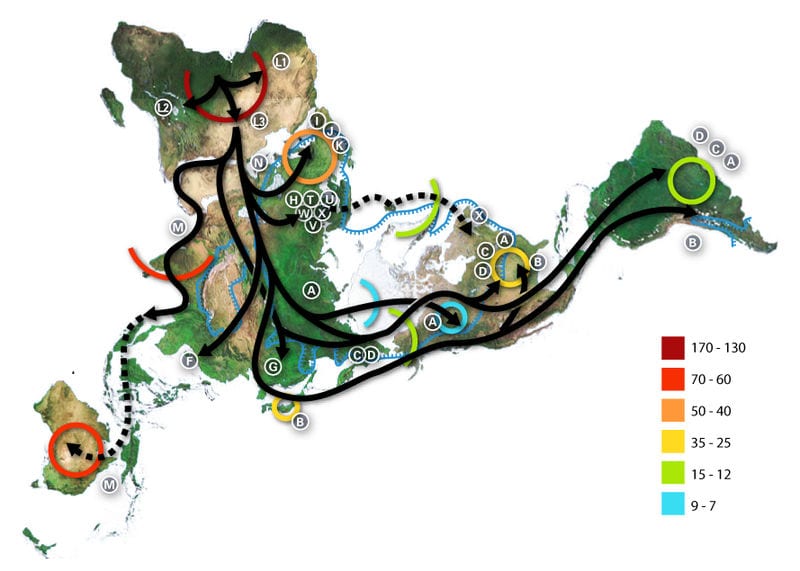Ancient human migrations timeline

Paths of ancient human migrations based on mtDNA. Numbers refer to thousands of years ago.
Accessed from Wikipedia 18 June 2013.
Introduction – Ancient human migrations timeline
Human migration, the movement of people from one place to another, has been a fundamental aspect of human history. From the earliest nomadic hunter-gatherer societies to the complex globalized world of today, the story of human migration is one of resilience, adaptation, and innovation. This essay delves into the rich tapestry of human migration across the globe, tracing its origins from ancient times to the present day.
Ancient Human Migrations The history of human migration dates back to the earliest days of Homo sapiens. Our ancestors, the early hominids, began their journey out of Africa around 60,000 years ago, spreading across the continents in waves of migration. These ancient human migrations were driven by a variety of factors, including changes in climate, the search for resources, and the quest for new territories.
One of the most significant ancient human migrations was the peopling of the Americas. Around 15,000 years ago, the first humans crossed the Bering land bridge from Asia into North America, eventually spreading southwards into Central and South America. This migration marked a pivotal moment in human history, leading to the settlement of a new continent and the development of diverse cultures.
The Rise of Civilization and Trade Routes As civilizations began to emerge in different parts of the world, human migration took on new dimensions. The ancient Egyptians, Mesopotamians, and Indus Valley civilizations engaged in trade and cultural exchange, leading to the movement of people across vast distances. The Silk Road, one of the most famous trade routes in history, facilitated the exchange of goods, ideas, and people between East and West.
The Age of Exploration and Colonization The period of European exploration and colonization in the 15th to 17th centuries had a profound impact on human migration. European powers such as Spain, Portugal, and England established colonies in the Americas, Africa, and Asia, leading to the forced migration of millions of people through the transatlantic slave trade. This dark chapter in human history reshaped societies and cultures around the world, leaving a lasting legacy of displacement and trauma.
Industrialization and Urbanization The Industrial Revolution of the 18th and 19th centuries brought about significant changes in human migration patterns. As people moved from rural areas to urban centers in search of work, cities grew rapidly, becoming melting pots of diverse cultures and identities. The mass migration of people from Europe to the Americas, Australia, and Africa during this period transformed the demographic landscape of these regions, laying the foundation for the multicultural societies we see today.
Modern-Day Migration Trends In the 20th and 21st centuries, human migration has continued to shape the world in profound ways. Globalization, technological advancements, and political upheavals have led to unprecedented levels of migration, with millions of people crossing borders in search of better opportunities, safety, and refuge. The refugee crisis, climate change, and economic disparities have all contributed to the complex web of migration challenges facing the world today.
Human migration is a timeless phenomenon that has shaped the course of history and defined the human experience. From the ancient migrations of our ancestors to the modern-day movements of people across borders, the story of human migration is one of resilience, adaptation, and hope. As we navigate the complexities of a rapidly changing world, it is essential to remember the rich tapestry of human migration that connects us all across time and space.
Timeline
BP
2 million – Emergence of genus Homo in Africa
2 m -50,000 – Homo erectus widespread across Eurasia
c. 300,000 – Fossils of Homo sapiens found in Morocco suggesting Africawide distribution at this time
200-150,000 – Homo sapiens found in fossils of East Africa
80-90,000 – Anatomically modern humans leave Africa to populate the world
70,000 – earliest evidence of modern humans in SE Asia
65,000 ± 5000 – earliest evidence of humans in Australia
50,000-10,000 – Ice Ages, peaking c.18,000 BP, with sea levels 100-150 m lower than today
50,000 – H. sapiens populates Australia, preceded only by bat & rodent placental mammals
52,000-40,000 – World’s first figurative rock art found in Borneo and Sulawesi
43,000 – H. sapiens populates northern Europe
43,000-22,000 – Lake Mungo a fertile lake system –site of oldest Aboriginal remains
35,000 – H. sapiens populates Tasmania
30,000-25,000 – General occupation of Sahul complete(except arid centre)
30,000-5,000 – Volcanic activity Mt Napier, Mt Gambier, Mt Eccles
25,000 – H. sapiens populates Britain
18,000 – H. sapiens populates North America
14,000 – King Island separates from Cape Otway
13,000 – Flinders Island separates from Wilson’s Promontory
12,000 – H. sapiens populates South America
. . . Gwion Gwion Kimberley rock art dated to about this time
10,000 – H. sapiens the only remaining species of Homo
8,000-6,000 – Formation of Great Barrier Reef; separation of New Guinea & Australia by Torres Strait
6,000 – Sea adjusts to present-day levels
5,000-2,500 – Peopling of the Pacific
4,500 – Chinese farmers migrate into SE Asia
3,000 – Settlement of Torres Strait Islands
1,500 – Trade route connecting Mediterranean, W Asia, Africa and China with minor trade into Indonesia
1,000 – Settlement of Polynesia
CE
300 – Settlement of Easter Island
400 – Settlement of Hawaii
1280 – Settlement of New Zealand
1980s – Genetic anthropology begins mapping the path of human migration
1987 – mtDNA traces human family tree back about 10,000 generations to first female ancestor ‘Eve’
2011 – First completed Aboriginal genome
First published on the internet – 1 March 2019
Phases of human-plant interaction – Natura, Agraria, Industria, Informatioa – Courtesy Rob Cross 2019.



0 Comments